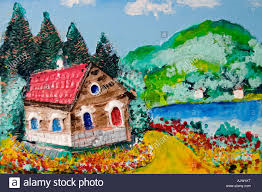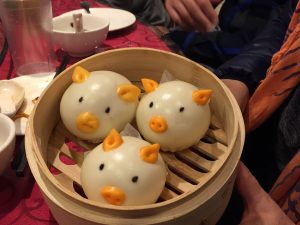Do You Feel Inspired by Quotable Quotes? Then You’re in the Right Place.
Happy New Year, Friends!
To celebrate the onset of 2019 (can you believe it? It’s 2019!!!), I am sharing a bunch of quotable quotes that bring me joy and inspiration. I have embedded the quotes in my art work to add some punch and interest to the words. I love pairing art/photography and words, and I hope you do, too. If you wish, please share one of your favourite quotes here. I’d be thrilled to share your quotes in a future newsletter.
Painterly Cindy and More Blogs about How to Make a Quick and Easy Collage Painting that will Appeal to a Child or Adult Alike
Ever wanted to create a quick and easy collage piece whose sensibilities might appeal to a child (a grandchild, niece, nephew, your own child)
or an adult?
Sometimes we want to create something simple yet interesting as a gift for someone. In my case, I set the bar high. I made a bunch of wall-art for our first grandchild, Kai, so now I feel compelled to continue the tradition. That’s okay. I have nothing but time on my hands, right?
In this piece, I started with a blank canvas. I used a 10×10 inch stretched canvas. I painted the canvas with something called white GESSO. I thinned the GESSO with water as I painted (used a spray bottle). I used two coats of GESSO to create a nice white surface.
 Lovely blank piece of stretched canvas. So much potential.
Lovely blank piece of stretched canvas. So much potential.
When dry, I stamped muted colours of acrylic paint all over the place. I used a small SEA SPONGE to paint over alphabet and shape stencils. I let that dry.
Did I mention that the day on which I was painting we were experiencing pouring rain? Cats and dogs, in fact.
 Some people say, “Yuck, rain.”
Some people say, “Yuck, rain.”
I say, “Hurrah!”
I painted the edges of the canvas with black ACRYLIC paint at this point. I usually do this step at the end. I know I have to repeat this edge painting step at the end of the project. Silly me!
I used GOLDEN BUFF MEDIUM (Acrylic) to cover the stencilled canvas.
The really fun part: I used images from a discarded adult colouring book to create a still life piece. With a pair of ultra sharp scissors I cut out ‘shapes’ like a bowl, some butterflies I found in the colouring book, an apple or apricot shape, a banana shape and a bunch of grapes. I did not draw before I cut. Repeat! I did not draw before I cut. I also found some words in the book that I liked and snipped them out, too. I used GEL MEDIUM (an acrylic product) to glue the back of the shapes and words to my canvas. I added GEL MEDIUM over these items, too. I smoothed using the edge of a used gift card. I let everything dry.
 I actually love how it looks just like this. It has a Zentangle feel.
I actually love how it looks just like this. It has a Zentangle feel.
I used ACRYLIC PAINT MARKERS and PAINTERS markers to add colour and more dimension. I also outlined some objects here and there as well as some words. Then I used an ACRYLIC PAINT MARKER to create the illusion of the bowl sitting on the table (yellow colour).
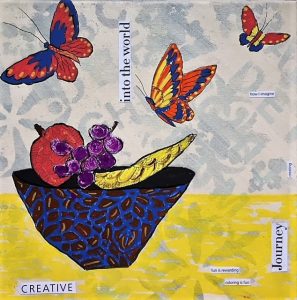 It is looking pretty cool here but it’s missing some pop!
It is looking pretty cool here but it’s missing some pop!
For this next part I scribbled (yup) some charcoal here and there to give an illusion of shadows. Them I smeared it all up and covered it all with acrylic medium to ‘fix’ the charcoal in place. Otherwise the charcoal would smear if anyone touched it. So much to learn, right?
Then I let the piece sit for a week. Yup. Just like I do with my writing. I let things sit and after a week, I see what else might be needed. Can you guess what I added to the painting?
It never hurts my feelings if you share my blog and / or newsletter with friends. In fact, I’d like that very, very much. CM
Walkerton Herald-Times
I have a bi-monthly opinion column appearing in the Walkerton Herald-Times. Links to the columns also appear online at SouthWesternOntario.ca.
Here are the links to some of my most recent columns:
Let me know your thoughts on these topics by writing a comment.
Are You a Late Bloomer, too?
In my October newsletter, we were discussing how I feel like a late bloomer sometimes, that I arrived at fulfilling my creative mojo at such a late age. And sometimes, just sometimes, that feels a little daunting!
Here is the rest of that article:
Something new for me is digital designing (see above). It is like painting using a mouse. I love these new challenges, even though I AM a bit old to be doing so much learning and experimenting. Or am I?
Intrigued by the concept of being a late-bloomer, I studied others who arrived at making art later in their lives. Take Bill Traylor. He was broke and homeless at the ripe old age of 85! To pass the time, he made art and displayed it on the streets of Montgomery, Alabama. Another artist who wanted to support Bill’s creative expression bought Bill better art tools. Bill Traylor made 1000 + pieces in his life and many are on display to this day. To learn more follow this link: Bill and his art.
This short article (by Marcia Smalley) about awakening your inner artist later in life emphasizes many points but the one that resonated with me is the idea of Beginner’s Mind. Allowing our creativity to take hold means there are no rules. Imagine! Just letting yourself do whatever you want with a few bottles of paint or a box of smelly markers. Sounds fun! What are your experiences? Perhaps write about them via the CONTACT ME page.
September Brings up the Topic of Vision and the Arts (Visual, Writing and Otherwise)
In June 2018 I experienced floaters in my eye. This resulted in me having to have emergency laser surgery on a tear in my retina. There is a history of detached retinas on the maternal side of my family.
As you would expect…
The inner artist came out in full force during this ‘brush with lost eyesight’ experience. First, I wrote a fictional account about the experience. Somehow through using the fictional story telling lens rather than memoir writing techniques, I could more honestly integrate the emotional response of my ‘character.’ There was greater clarity in the writing rather than pouring my own emotions into a retell. Secondly, I researched visual artists and authors who are blind and still manage to create (visual art, writing).
Here are some of what I wanted to share with you.
Esref Armagan was born with non-functioning eyes. He is a Turkish-born visual artist whose work is simply amazing. He starts his paintings by using a Braille stylus to etch the outline of his sketches. Then he uses his fingers and oil paint to apply colour. He doesn’t want his colours to smudge so he allows the paints to completely dry between applications. He apparently receives no assistance from others during the process. He requires complete silence in order to paint. To learn more go here.
Art by EsrefArmagan ~ Image source click here.
Jorge Luis Borges, Argentine writer ~ A prolific writer and thinker, this writer’s vision deteriorated in the latter part of his life. His mother, who lived until age 99, became his personal secretary, recording his thoughts and ideas. Learn more here.
Arthur Ellis is a UK painter. In 2006 he fell ill to Bacterial Meningitis. This disease caused him to lose his eyesight, as well as most of his hearing and balance. He continues to create albeit using different materials and techniques. Via this link to learn more. At the site you can view his pre sight loss (lots of portraiture work) and post sight loss work. I was most fascinated by his visual journal where he demonstrates ‘how he does it.’
Jean Little, Guelph Ontario ~ I learned about Jean Little when our children were in elementary school. They often borrowed her novels from the school library. Jean is a prolific writer. Blind since birth, she uses a talking computer to create her stories. Jean enrolled in regular classes in elementary and secondary school and has a university degree in English Language and Literature. She has a seeing eye dog, Honey. Learn more about Jean here.
Image source click here.
Do you have a special affinity to an artist (visual, musical, dance) and/or writer who is faced with physical/mental challenges? If so, please add a comment to the comment page on my website.
Painterly Cindy or More Talks about the Merits of Longhand Creative Writing
I love to create while writing longhand.
While I have not conducted clinical research on myself or anyone else for that matter, I believe that the act of pushing a pen on paper keeps me sharp. I believe this with such conviction that I write with a pen on paper every single day during a timed (15 minute) session. I don’t especially care what I write about. I don’t usually have a plan of what to write but I do it regardless. And, usually by the end of 15 minutes, I have written a few sentences that actually make sense.
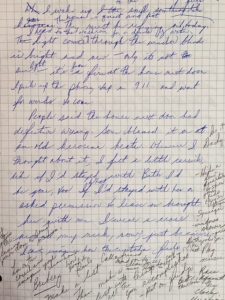 What my longhand looks like. Yikes! Yup. I can read it.
What my longhand looks like. Yikes! Yup. I can read it.
When Stephen King writes about his characters, he does it longhand. James Patterson, apparently, writes his entire novels with a pen. For many of us, pushing a pen (or pencil) on paper feels good. There is a sense of space, of creativity, of genuineness. If writing is a consequence of dreaming and thinking, then the process of putting ideas to paper seems more natural than clicking the keys of a keyboard.
Let’s go back to that idea of keyboarding or the earlier term I used in my monthly newsletter, keypunching. There is a nosy rhythm to tapping keyboard keys, a boring, mind-numbing sound as my fingers pound the letters, stringing letters into words, words into phrases, phrases into sentences, sentences into paragraphs. I’m boring you, right? When I compose sentences on paper, I draw arrows, rectangles, stars and circles all over my work. I can visualize exactly where I wrote a certain idea. I can see it in my dreams. I make fewer errors of ideas, spelling or grammar when I write longhand. Further, I don’t have to deal with the dreaded auto-correct feature.
Does it mean extra work? Sure. Eventually I have to transcribe my scribbles onto my iPad or computer but that is part of the process, of slowing things down, of creating something organic and real. When one of our children attended what used to be called grade 13 in our local rural high school, she enrolled in a course called Writer’s Craft. I wish there had been such a course while I was a high school student. The idea of pen and notepad evokes an idea of craft, doesn’t it?
When I write longhand, I have the ability to shut the world out, to let my thoughts flow through the movement of the writing tool on the page. The process of doing this feels like the fluid ink is keeping me company. There is a deep uninterrupted connection from my brain to the paper. I never have to face a blank computer screen, the little cursor with its never-ending blinking. Writing longhand brings me pleasure. I can sit in a corner of my favourite coffee shop. No one cares what I’m up to. I could be writing out my shopping list for all they care. Likely, they don’t care. And that’s fine by me.
NOTE: At least when writing longhand, I’m not distracted by other tasks, like repairing my website or adding pictures to my Instagram account.
Check out these ideas by Joshua Ferris, Then We Came to the End. (below)
‘I’ve worked this way for as long as I can remember. The Rhodia [pen] allows me to move around at will, as if on a computer, so that if I get stuck, I can just scoot over and start something new elsewhere. But because I’m still writing on the same page, I can always reference what I’ve abandoned, in case I want to crib from it a sentence or a thought. And if I have a random thought, I can jot it down somewhere else and then come back to it — and there’s room for that.
Writing longhand allows me to sit and think without a screen blinking at me. I need that. The long blank page reminds me that I’m not likely to write an entire novel in a day, so why not just calm down and concentrate on the sentences. Why not try to make the sentences — a few of which I can finish in a day — as good as they can be?’
The only drawback to writing longhand is its secret strength. It slows me down.’
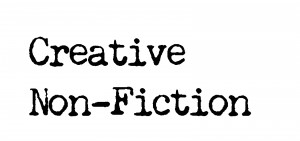 Looks so clinical, doesn’t it?
Looks so clinical, doesn’t it?
Writing longhand allows me other perks:
~ no interruptions from Twitter, email and Facebook
~ I can write absolutely anywhere. I don’t need to remember to bring or charge my device. If I have a pen or pencil plus paper, I’m golden.
~ there is something inherently creative about making shapes on paper, even if they are letters rather than doodles or doodles rather than letters.
~ the act of slowing down allows me to juice up the ideas
~ there is something very sensual about the scritch-scratch of the writing tool on the paper
~ I’m a leftie and my handwriting leaves something to be desired. I am forced to get the next word down and not go back and reread what I’ve written. Longhand forces me to forge ahead.
What do you think about longhand writing? Do you take part in longhand or do you prefer a keyboard? And why? Answer by writing a comment on my comment page on this website.
I recommend that you read this short article on the benefits of Slow Writing.
Want to get my monthly newsletter? Click here to become a subscriber.
Here is my entry to the William Willard Campbell Poetry Contest
This spring I entered two poems into the William Willard Campbell Poetry Contest. One of them, ‘If I Could Take Words, I Would,’ placed Top Ten. While the entry did not win, I was pleased with the results! The contest celebration occurred on June 24 at The Meeting Place in Wiarton, Ontario.
Here it is: If I Could Take Words, I Would
Happy Canada Day ~ What am I Speaking about here? Why China, of course!
Travel can inspire the arts. Yup. I’m sure of it.
How can you see these sights and not be inspired? (Photos by John Matthews, spouse)
If you have read one of the earlier newsletters about China, you know I go silly over Giant Pandas. Wouldn’t you? The pandas resulted in me creating a t-shirt design featuring Mandarin characters, bamboo and giant pandas. I also created a cool design for a kimono.
Scorpion on the stick, anyone. Can’t you see that image going into one of my stories? Or piggy dumplings?!?!
Don’t know if I’ll ever paint a picture of John and me in a rickshaw, but you never know? I certainly have been including more red in my paintings as a result of this trip.
This farmer makes part of his living showing tourists how to pop rice. For sure this image will appear in my writing.
To support my argument on why travel can support creativity and the arts, check out these two short articles for more reasons:
Painterly and Cindy and More on ~ Book Clubs are for Writers, too
Painterly Cindy and More Talks about Book Clubs ~ Why they are good for writers
If you are a subscriber to my newsletter, you have already read point one on why it’s important to your writing creativity to belong to a face-to-face book club, so jump down to point 2 to read the rest of the article. If you are not a subscriber, why not? Here’s the link to sign up. I promise. The most you’ll receive is ONE newsletter per month.
1-Belonging to a book club forces you to read books you might not normally know or consider. Sounds like you are back in high school? That’s not the point. Let me give you an example. I recently ‘had to read’ this book for book club: Frank Parker Day’s book ‘Rockbound,’ the 2005 selection for Canada Reads. This book was a struggle for me! I admit it. However, because I had committed to reading it for book club, I persevered and I am glad I did. I learned a lot about the eastern part of Canada, and how to write accents in dialogue.
2-By taking part in a book club makes you socialize. Writing can be quite solitary. So, by showing up for book club, you are forced, yup, forced, to show up for something social. Those connections are good for your brain, and foster a sense of belonging. Besides, belonging to book club can also provide fodder for character development. Shhh! Just don’t tell the book club you are doing research.
3-At book club, everyone gets a chance to speak and some people share a lot! As you listen to their ideas about what worked (and didn’t) in the book, these ideas can inform your writing. Ideas (both good and bad) about plot, character, and setting, to name a few, will assist you in your writing, if you let them.
Book club also allows you to talk about good writing. This can build confidence about literature and even your own work.
4-Preparing for book club can be like reading any book. Reading is a form of travel. You can find yourself in a new setting or a different period or facing issues you never knew existed. It’s a cognitive exercise, of sorts. It’s an opportunity to crystallize your own ideas and techniques for writing. For instance, I recently read some short fiction by Rick Moody, an author I was not familiar with. His name came up during book club’s exploration of short fiction collections. Now, he is an author I want to study and emulate.
See you in July when I discuss the merits of travel on creativity (visual art and writing).
Follow me on Facebook.
Find me on Twitter.
I’m on Instagram too.

 Write to a timer. Click clock to obtain image source.
Write to a timer. Click clock to obtain image source.




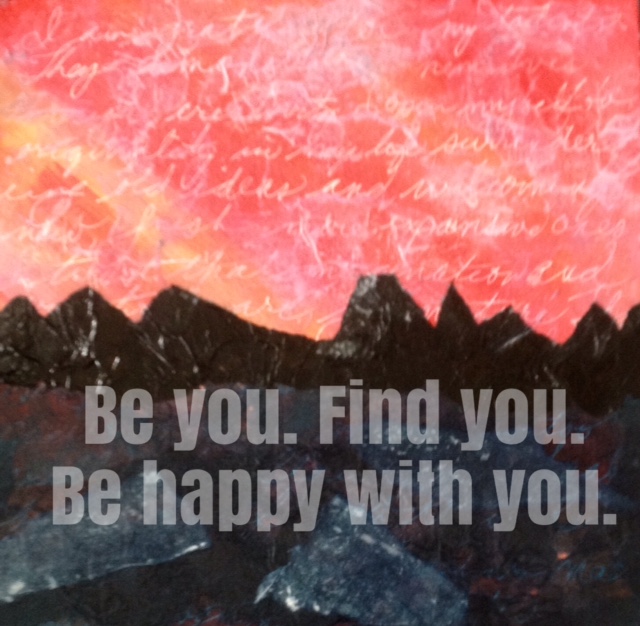




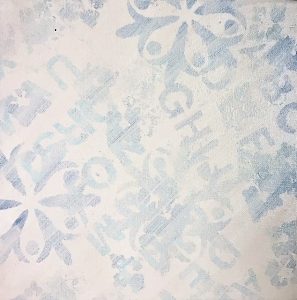
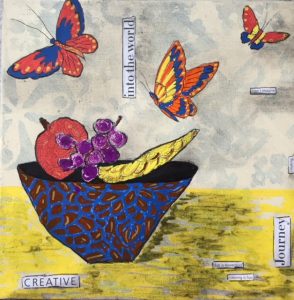
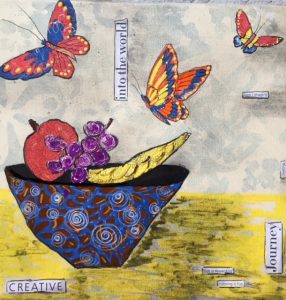 I added a few scribbles on the bowl and white dots on the butterflies. That’s about it. It might not be done yet but I like it just how it is and I hope my newest grandchild (a granddaughter) will, too.
I added a few scribbles on the bowl and white dots on the butterflies. That’s about it. It might not be done yet but I like it just how it is and I hope my newest grandchild (a granddaughter) will, too.
